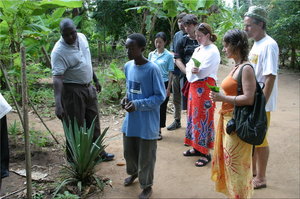

|
|
On Spice Tour with Rambo, the multilingual guide
|
We see cinnamon (which is actually the bark of the cinnamon tree, which is cut down to harvest the bark and then used for firewood), the "lipstick tree" whose seeds are intensely red and used for their colour, aloe vera, sisal (used to make tequila), ginger, tumeric, breadfruit, cardamon, the "Dorian" tree (whose fruits taste great but smell so bad that it is illegal to eat them in public in Singapore), lemongrass, cassava, pineaples, mango trees, cloves (the "King of the spices" here -- cinnamon is the queen), limes, passion fruit, guava, vanilla (a creeping vine), nutmeg, and black pepper. Not all of these are spices of course.
Palm trees are everywhere. The teenage kid takes off his shoes, ties his feet together with some plant fibers, and shimmies up a palm tree effortlessly. He drops down several coconuts which are still green, and then expertly cuts them open and hands them around. The coconuts are hollow and full of water. The water has a very slight coconut flavour. On the inside of the nut, there is about 1/4" of the white substance that we associate with coconuts. When a coconut is ripe, the outside becomes brown and fibrous. We see these coconuts being processed. A man impales them on a metal spike, rips apart the husk, and tosses aside the core, which is maybe 4" in diameter. We have seen those same cores sold at market in town.
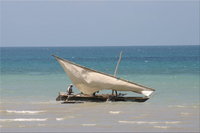
|
|
Almost got a picture of a Dhow under sail
|
We are out of cash. To pay for the last night's hotel and our airport departure taxes, we need another $200. It is my turn to get some. Bruce assures me that the money changers at the airport are as good a deal as anyone in town, and it is Sunday and the places in town would be closed. So I resolve to ride the Dala Dala to the airport.
At the central terminus, I just shout "Airport?" and am directed onto a particular vehicle, which indeed zooms off in the right direction. But after a while, there seems growing unease with me pointing at the airport on the map, and I am given to understand that I should be on another line which branches off on another road. So I get off and wander over there, but no Dala Dala comes. Instead I am collared by a kid who wants to give me a taxi ride. Sure, why not. Even though I could walk to the airport from here, I agree to be driven there for $3. Almost immediately, the kid fends off another hopeful taxi driver who has stopped. I am led across a vacant lot to the most decrepit Toyota you ever did see (which has long ago shed its muffler) and the kid says something about OPEC. I assume I didn't hear right, but... we drive up to a small boy holding a 2L plastic jug and sure enough, the contents of this jug are funnelled into the gas tank. Then off to the airport, where the kid has only a 1000 shilling note to his name, so he ends up getting $4 because I don't have anything smaller than $5. I wish him luck and tell him to get some more OPEC.
The arrivals hall is deserted as usual. Only one of three money changers is open, and he is not the one who takes credit cards. Indeed, the one who does has a sign saying closed on Sunday. But never fear, they say he'll be there in a few minutes. Meanwhile I wander out the other side of the building and watch the planes.
I finally get my $200, and walk back out front, where I am accosted first by the official taxi drivers, then the second tier gypsy cab types 20m further away. I'm walking, I say. After all, it's only a few hundred meters to where the Dala Dala line (the one I was on, which was the right one after all) passes. The offered price goes from $5, to $4, to $3 for a ride downtown. Oh what the heck. But this time I want change for a $5! A man helpfully offers to change my money and hands me back three $1 bills and a $2. I've never seen one of these, and pocket it to keep.
So I get into an ancient Mercedes owned by a guy who speaks pretty good English. The first stop is, you guessed it, a gas station, where my $3 are handed over and 3.21 litres of gasoline are put into the car. This is not enough to budge the gas gauge off "empty" or extinguish the warning light. The driver says hopefully there are no cops because he is not a licenced taxi. I offer to duck if any are in sight. I ask to be dropped a little ways short of downtown because I want to walk up the seashore and explore some more.
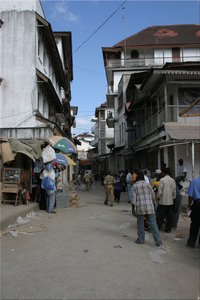
|
|
Typical street scene in central Zanzibar Town
|
Walking onward, I pass an Indian and then an Italian restaurant that look pretty good (both very close to the ritziest hotel I've seen, the Serena Inn), and then emerge in the heart of Stone Town again. I now have a mind to buy some banana leaf pictures, and earnestly look at a couple hundred to pick out four that I like. Haggling for the price is done with a calculator. It starts at $28, and I start at $10. We meet at $15, which is probably a few dollars too high because I didn't take the penultimate step of walking away and waiting for the seller to catch up with his lowest offer! Another seller gets so excited at having a live customer around (apparently Sunday afternoon at this time of year gets a little slow) that he offers me stuff from other people's booths. I would actually buy a huge packet of saffron offered for $4, but the owner of the booth objects (it is marked at $8).
I pass an internet cafe. The price is 50 cents for half an hour, and the machines are ordinary Windows computers; your money gets you into a room and then you can use them as you please. In the "My Documents" directory there is a Word document which is a letter firing someone from his job for negligence. Instant messaging works too and I manage to chat with a couple of people. My brother Matthias tells me he's just getting ready to go skiing. It is, of course, 8 hours earlier in the day, and the opposite season back home. I compose the fifth and last of my on-the-road emails to friends at home.
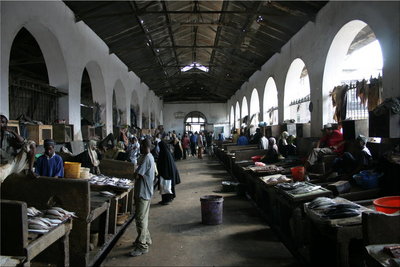
|
|
The Fish Market
|
Back at our beach house, I am thirsty for soda pop, but there is none left in the fridge, so I grab two empties and walk up to the main street. Both the stores where I've usually bought pop are closed, but seeing the empties, a man immediately leads me to another kiosk a little distance away, where sure enough, I get what I want, for 25 cents a bottle as usual. I love drinking pop (Fanta and Sprite usually - this is Coca Cola country) out of the tall, skinny 350ml glass bottles they use here. Few places have cans, and the cans cost much more.
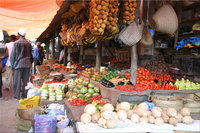
|
|
Vegetable stands in the market
|
Our ride home is a minibus taxi. Without any haggling, the price for the 10km ride for the five of us is $7.